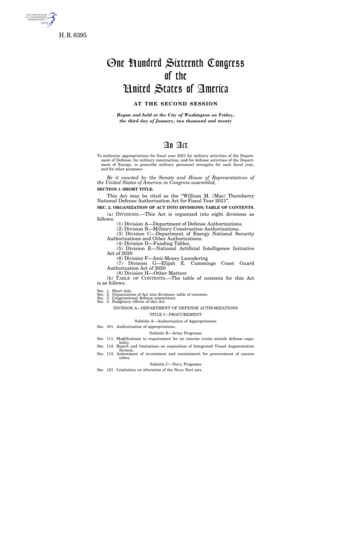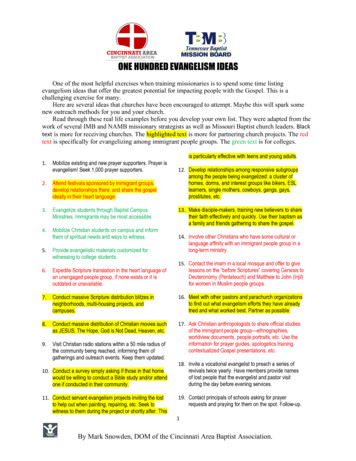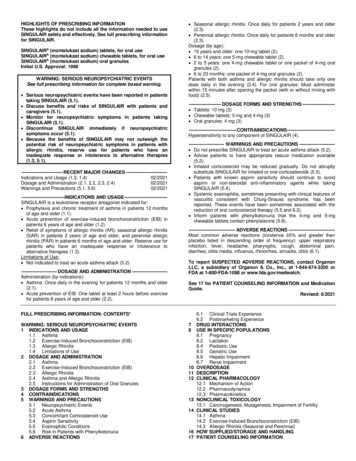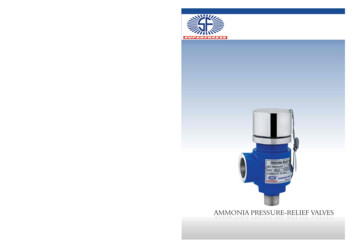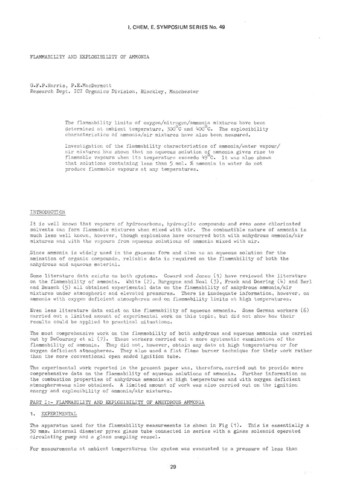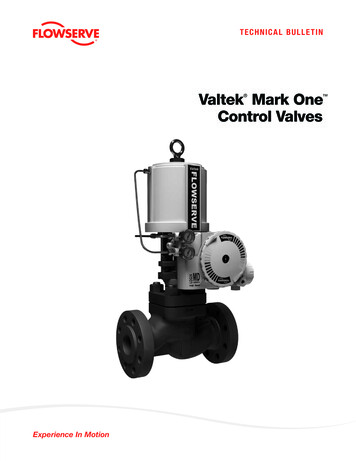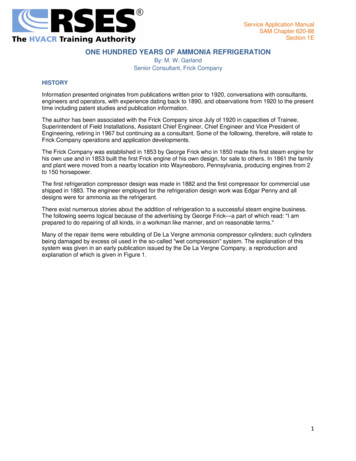
Transcription
Service Application ManualSAM Chapter 620-88Section 1EONE HUNDRED YEARS OF AMMONIA REFRIGERATIONBy: M. W. GarlandSenior Consultant, Frick CompanyHISTORYInformation presented originates from publications written prior to 1920, conversations with consultants,engineers and operators, with experience dating back to 1890, and observations from 1920 to the presenttime including patent studies and publication information.The author has been associated with the Frick Company since July of 1920 in capacities of Trainee,Superintendent of Field Installations, Assistant Chief Engineer, Chief Engineer and Vice President ofEngineering, retiring in 1967 but continuing as a consultant. Some of the following, therefore, will relate toFrick Company operations and application developments.The Frick Company was established in 1853 by George Frick who in 1850 made his first steam engine forhis own use and in 1853 built the first Frick engine of his own design, for sale to others. In 1861 the familyand plant were moved from a nearby location into Waynesboro, Pennsylvania, producing engines from 2to 150 horsepower.The first refrigeration compressor design was made in 1882 and the first compressor for commercial useshipped in 1883. The engineer employed for the refrigeration design work was Edgar Penny and alldesigns were for ammonia as the refrigerant.There exist numerous stories about the addition of refrigeration to a successful steam engine business.The following seems logical because of the advertising by George Frick—a part of which read: "I amprepared to do repairing of all kinds, in a workman like manner, and on reasonable terms."Many of the repair items were rebuilding of De La Vergne ammonia compressor cylinders; such cylindersbeing damaged by excess oil used in the so-called "wet compression" system. The explanation of thissystem was given in an early publication issued by the De La Vergne Company, a reproduction andexplanation of which is given in Figure 1.1
Service Application ManualSAM Chapter 620-88Section 1EONE HUNDRED YEARS OF AMMONIA REFRIGERATIONBy: M. W. GarlandSenior Consultant, Frick CompanyThe extent of such compressor repairs as made by George Frick would seem to be the logical reasoningfor adding refrigeration compressors and systems to an already prosperous steam engine buildingbusiness.The De La Vergne vertical compressor was double acting; it used spring loaded inlet and dischargevalves and relied upon oil injecting to offset losses created by excessive clearance areas. (Figure 2)2
Service Application ManualSAM Chapter 620-88Section 1EONE HUNDRED YEARS OF AMMONIA REFRIGERATIONBy: M. W. GarlandSenior Consultant, Frick CompanyIn the first Frick design, oil was limited to that amount necessary for lubrication purposes. Excessiveclearance volume was eliminated by the use of a single compression at the top end of the vertical cylinderand with the discharge valve in the head and inlet valve in the piston. With both presenting a flat surfaceflush with the cylinder head and the piston head. Clearance volume was limited by the distance betweenthe two heads. Opening of the inlet valve was assisted by a spring and by inertia; closing of the inlet valvewas also assisted by inertia. Spring loading was provided for retention of discharge head assembly inplace on the top of the cylinder wall for safety purposes, in the event of an accidental liquid refrigerantreturn to the compressor. The inlet vapor entered the bottom cylinder area below the water-jacketed area.Teachings at that time described the water jacketing as being used to reduce heat conductivity from thehot discharge area into the incoming vapor area. (Figure 3)3
Service Application ManualSAM Chapter 620-88Section 1EONE HUNDRED YEARS OF AMMONIA REFRIGERATIONBy: M. W. GarlandSenior Consultant, Frick CompanyOpen “A” Frame TypeAll of the above features were incorporated in that first single acting, inlet valve-in-piston design whichproduced a most efficient reciprocating compressor. The concerns of minimum clearance volume, least4
Service Application ManualSAM Chapter 620-88Section 1EONE HUNDRED YEARS OF AMMONIA REFRIGERATIONBy: M. W. GarlandSenior Consultant, Frick Companyresistance to inlet valve opening, and least heat conductivity from discharge to suction are today thedesign aims in compressor construction.Having participated in the performance tests of many of those early compressors makes it possible for theauthor to state that the indicator cards taken from those tests show a performance never exceeded byany later design. The later designs provided for higher RPM ability and lighter parts, but their structureintroduced a greater percentage clearance volume and other losses.Horizontal compressors with double acting cylinders were competitive from the viewpoint of ground-levelaccessibility; however, because of excessive clearance volume they never matched the volumetricefficiency of the vertical single acting compressor. (Figure 4)Until about 1900, the vertical single acting and horizontal double acting compressors were predominant inall ammonia refrigeration applications, all of these compressors being of the cross head piston rod type.(Figure 5)5
Service Application ManualSAM Chapter 620-88Section 1EONE HUNDRED YEARS OF AMMONIA REFRIGERATIONBy: M. W. GarlandSenior Consultant, Frick CompanyProof of the efficiency of the single-acting structure, with inlet valve in the piston, was demonstrated at thebeginning of the 20th century. That structure was adopted by all of the major compressor manufacturersinto the enclosed single-acting compressor with the piston serving the dual function of accepting theconnecting rod thrust and compression of the ammonia vapors. The result was a tremendous saving instructural weight and cost of manufacture per ton of refrigeration. This enclosed type structure eliminatedindividual piston rods and required refrigerant sealing at the crankshaft projection from the crankcaseonly. (Figure 6)6
Service Application ManualSAM Chapter 620-88Section 1EONE HUNDRED YEARS OF AMMONIA REFRIGERATIONBy: M. W. GarlandSenior Consultant, Frick Company7
Service Application ManualSAM Chapter 620-88Section 1EONE HUNDRED YEARS OF AMMONIA REFRIGERATIONBy: M. W. GarlandSenior Consultant, Frick CompanyRefrigeration in practically all applications, ice making, breweries, cold storages and freezers were, untilthe late 1920's, manually operated with remarkable efficiency.For example, as a trainee in 1921, it was the author's nighttime chore to manually operate the handexpansion valves on two one-hundred-ton can-ice-producing tanks during the acceptance tests. Then,and now, the prevailing question: What is the optimum superheat at the inlet to ammonia refrigerantcompressor? The engineer in charge at that time instructed the writer to adjust the expansion valves sothat the frost line at the entrance to the compressor did not recede or progress beyond a certain markingat the inlet strainer. To do so would reduce the ice-making performance.Additionally, the ice pullers were on a strict time schedule, making each ice pull at a specified time.Installations were made with a guaranteed ice production per ton of coal or specified number of KW perton of ice and this author never saw a single failure.The demand for automatic operation was in full swing in 1920. A major obstacle to automatic operationwas the problem of the crank shaft stuffing box. The type of packing material available required atightening of the gland bolts during shutdown and a release of the bolt tension during operation, toprevent leakage and overheating.Literature as early as 1880 indicated that system compounding for low temperature work was mostefficient. Observation by the writer in field installations and tests in the early 1920's showed that operatorsresisted the use of refrigeration suction pressure below atmospheric pressure because of stuffing boxleakage and air contamination in the system. This resulted in a determined research effort on the part ofthe company to develop a truly tight shaft seal. This was accomplished and put on the compressors andinto the market for replacement of packing in the late 1920's under the patent name of "Flexo Seal," thefirst successful mechanical seal for large reciprocating refrigeration compressors.With the shaft seal problem corrected, the next step was the development of a large volume compressorfor low pressure service in the first stage of compound compression systems for low temperature service.Note that despite the benefits of compounding being known in the 1880's, wide spread use did not occuruntil the early 1930's, and then only because of the development of oil pressurized shaft seals, whichcorrected overheating and air entrance problems.Recognition of faults, such as compressor clearance volume, valve leakage, etc., were all known then asthey are now. Oil injection to reduce leakage and provide internal cooling was recognized long before theadvent of the oil injected blade rotary and helical screw compressors, and with the same problem ofproviding full oil separation from the liquid refrigerant flow to the evaporator.At the time the author began, ammonia as a refrigerant was never considered a hazard to the operator orother occupants because instructions to all newcomers were:1. To immediately leave any area where there was a leak, and to then reapproach that area onlyfrom the upwind side for repair purposes.2. To immediately close the service valve in the liquid supply and permit compressor operation tozero pounds gauge.3. Regardless of an apparent safe pressure, never to open a line if frost continued to exist on anypart of the isolated area.Lubricants for ammonia compressors remain about the same. A paraffin base oil without additives wasthe exclusive lubricant in the U.S. until 1926. Naphthenic base oils were then introduced, and withcatastrophic results. The fault was an excess of resins which caused a varnish build up at piston rings,8
Service Application ManualSAM Chapter 620-88Section 1EONE HUNDRED YEARS OF AMMONIA REFRIGERATIONBy: M. W. GarlandSenior Consultant, Frick Companyand eventual seizure. It was the expensive warranty cost which caused compressor manufacturers to buyand sell a proper lubricant. The resin problem of the Naphthenic base oils was later corrected and doesnot knowingly exist at this time.So-called "Ice Machine Oil" was even then a problem item because a mineral oil of limited additives hasan atmospheric pour point no lower than -40 F. However, it did not prevent the development of lowtemperature systems. Test chambers at -75 F air temperature and -90 F ammonia operated successfullywith an oil rated at 0 F atmospheric pour point being used in the compressors. There exists practically azero miscibility of ammonia in a paraffin base oil. Thus, with a correctly designed oil removal means,ammonia will be free of contamination and provide the exact liquid temperature as shown in publishedtables.Oil separation in the liquid phase in the De La Vergne system was a method used until the early '20's andlater abandoned for reasons unknown; but it remains one of the best methods, if an adequate retentiontime for oil separation is provided.The writer has not observed any change in the differences of opinion regarding evaporator temperatureand oil pour point. Some advocate an oil to give least trouble in the evaporator, others recommend an oilbest suited to the compressor requirements. Experience over the years has proved that the lubricantshould be selected for best compressor life and any oil problem that might occur in the system can beeliminated by proper oil separation and proper means for oil removal.The rapid growth of the refrigeration industry, using ammonia almost exclusively up to 1930, causedsome application problems which under a slower growth rate might never have occurred. One of theproblems encountered then and at the present time is that of so-called "condenser bottling". Condensersin parallel occasioned by plant growth, were assumed to be at the same pressure-temperatureequilibrium; a condition that does not exist because of differences in size, cleanliness and location.Equilibrium is obtainable only in the liquid accumulation phase which occurs in the drain lines to thereceiver and then with a free vapor flow to the area of lowest vapor pressure of any of the condensers. Itis a challenge to present day ammonia system designers to recognize the need for a more careful studyof condensate collection and its retention in a multiple-condenser, single-receiver application.Dual effect compression was introduced in the "19 teens." An inlet port, through the cylinder wall at thebottom of the stroke, permitted high pressure ammonia vapor to enter the cylinder which was previouslyfilled with vapor that had entered through the inlet valves in the piston at the nominal plant suctionpressure. Frick Company made many of these dual effect compressors, in addition to cylinders forapplication to the vertical single acting cross head type compressors. Most notable of these were thelarge compressors at the Commonwealth Fish Pier in Boston.It was the advent of the mechanical shaft seal in 1930, and refinements in compound system designwhich greatly added to the growth of the food freezing and storage business. Controls with adequatereliability were being made available and practically full automatic operation was possible. Operatorduties were now confined to observations of oil levels, motor lubrication, condenser cleanliness andsystem tightness.Flooded evaporator refrigerant control was made a reality in the late 1920's by the introduction of reliablefloat devices and a scientific means for determining float level head.In the can ice making field there were many improvements: precooling water by using the refrigerationeffect available with the dual acting compressor; development of the low pressure air agitation sy
Senior Consultant, Frick Company . The extent of such compressor repairs as made by George Frick would seem to be the logical reasoning for adding refrigeration compressors and systems to an already prosperous steam engine building business. The De La Vergne vertical compressor was double acting; it used spring loaded inlet and discharge valves and relied upon oil injecting to offset losses .


